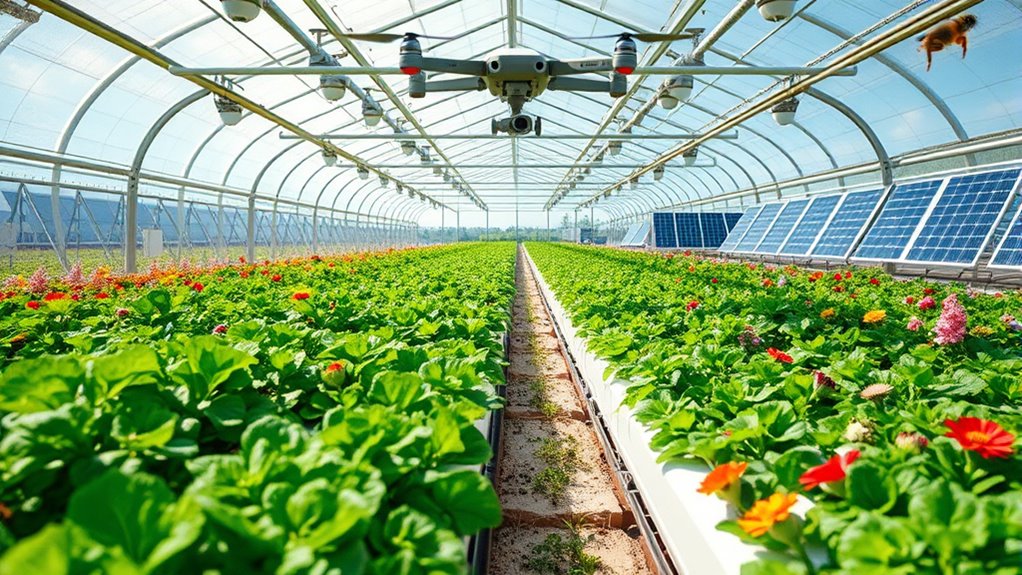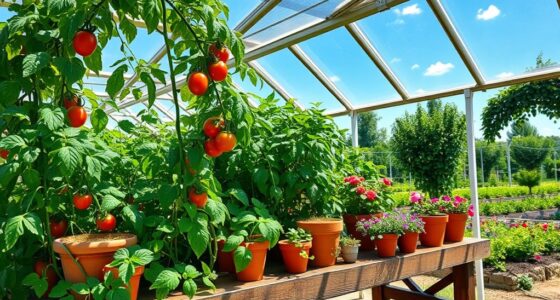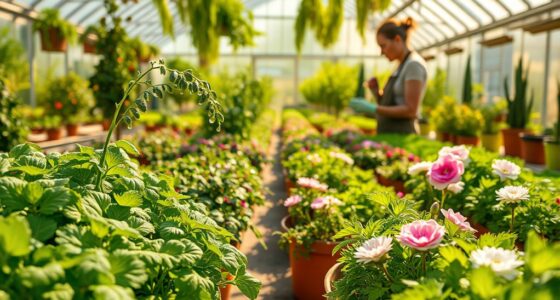The future of greenhouse farming lies in advanced technology and sustainable practices. You'll see IoT devices provide real-time monitoring while smart automation optimizes resources. With vertical farming and controlled environments, you'll enjoy year-round access to fresh produce. Economic growth in this sector is strong, fueled by demand for sustainability and local sourcing. Innovations like energy-efficient systems and hydroponics enhance resilience. You might be curious about the challenges and opportunities on this journey toward sustainable agriculture.
Key Takeaways
- Advancements in IoT and automation will enhance resource efficiency and optimize crop yield in future greenhouse farming.
- The integration of renewable energy sources, like solar, will reduce carbon footprints and increase sustainability.
- Vertical farming techniques will maximize space utilization, allowing for year-round production and improved food security.
- Market demand for sustainable and locally sourced produce will drive innovation and economic growth in greenhouse farming.
- Data analytics will play a crucial role in predicting crop health, enabling better decision-making and enhanced resilience against climate change.
Advancements in Technology Transforming Greenhouse Farming
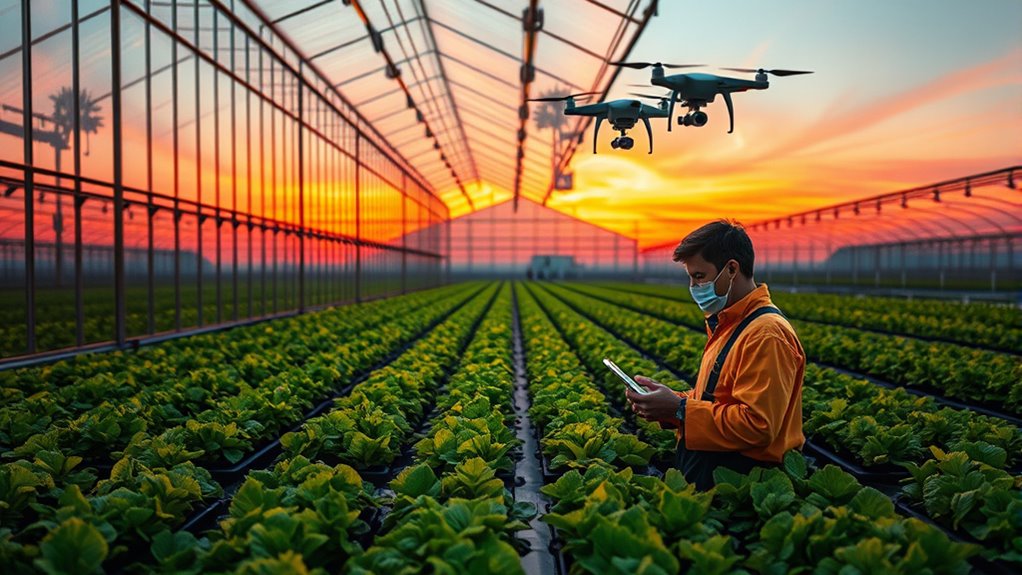
As technology continues to evolve, advancements in IoT and sensor technology are revolutionizing greenhouse farming, making it more efficient and productive. You can now leverage IoT devices to receive real-time data on temperature, humidity, and CO2 levels, allowing precise control over your greenhouse environment. Smart greenhouses enable year-round cultivation while minimizing resource waste, making them an attractive option for modern farmers. Additionally, incorporating solar energy solutions can enhance the sustainability of greenhouse operations by providing a renewable power source. The integration of efficient irrigation systems can further optimize water use, ensuring that plants receive the right amount of moisture without excess waste. Sensor integration helps you monitor soil moisture and nutrient levels, optimizing irrigation and fertilization. Moreover, utilizing self-directed IRAs can provide funding options for innovative agricultural investments.
With data analytics, you can predict crop health and growth patterns, enabling you to take proactive measures for better yields. Automated systems reduce your need for manual intervention, while continuous monitoring guarantees ideal growing conditions.
Sustainable Practices for a Greener Future
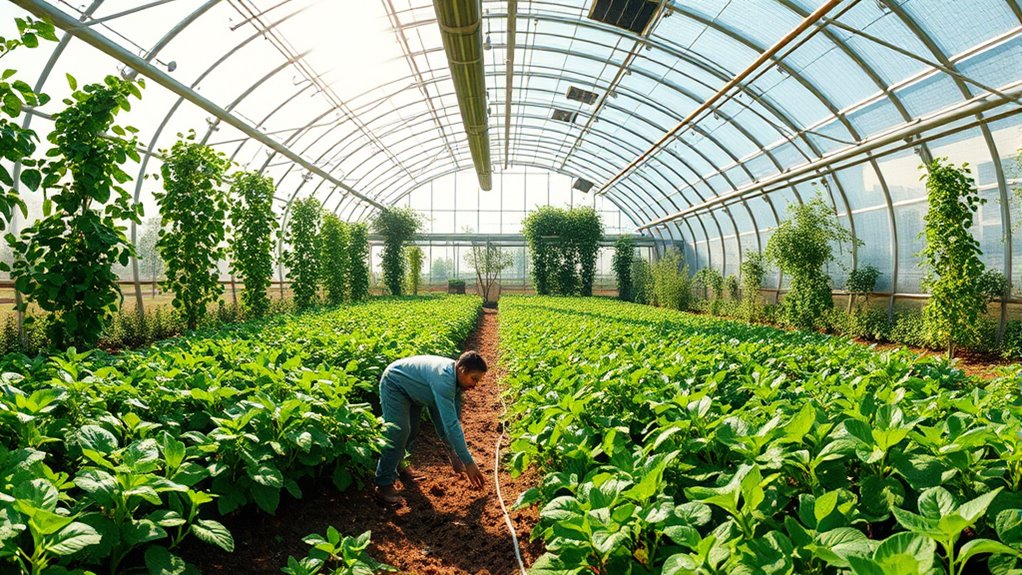
With advancements in technology paving the way for more efficient greenhouse farming, it's also important to focus on sustainable practices that guarantee a greener future.
You can start by implementing water recycling systems that minimize waste and assure precise irrigation, reducing excess usage. Consider hydroponics and aeroponics to optimize water consumption further. Additionally, water recycling systems can recirculate nutrient feedwater across multiple growing cycles, promoting efficient use of water resources. Furthermore, the development of biodegradable materials is crucial in reducing plastic waste in agricultural practices. Utilizing self-watering planters can also help manage water more effectively and support plant health. These pots utilize capillary action to draw water from a reservoir, ensuring plants receive consistent moisture without the risk of overwatering.
Incorporating renewable energy, like solar power and energy-efficient LED lighting, can greatly cut down your carbon footprint.
Embrace natural pest management techniques, such as integrated pest management and using beneficial insects, to minimize chemical use.
Finally, prioritize waste reduction by recycling materials and utilizing biodegradable options.
The Rise of Vertical Farming and Controlled Environment Agriculture

The rise of vertical farming and controlled environment agriculture (CEA) has transformed how we think about food production, especially in urban areas where space is limited.
By growing crops in vertically stacked layers, you can maximize yield per square foot while using innovative techniques like hydroponics and aeroponics. CEA tightly controls environmental factors, ensuring ideal conditions for plant growth. This method conserves water, requires 99% less land, and reduces the need for harmful chemicals. Additionally, vertical farms help cut transportation emissions by locating closer to consumers, making fresh produce more accessible. Backyard greenhouses are an excellent option for those looking to start their own farming journey at home, and implementing advanced techniques can further enhance crop quality and efficiency. For example, integrating vertical farming practices can dramatically increase overall productivity.
Growing crops in vertically stacked layers maximizes yield and utilizes innovative techniques for optimal plant growth.
With advancements in artificial lighting and climate control systems, you're witnessing a new era in agriculture that enhances food security and resilience against climate challenges, while offering a potential for 240 times the crop yields compared to traditional farms.
Economic Trends and Market Opportunities
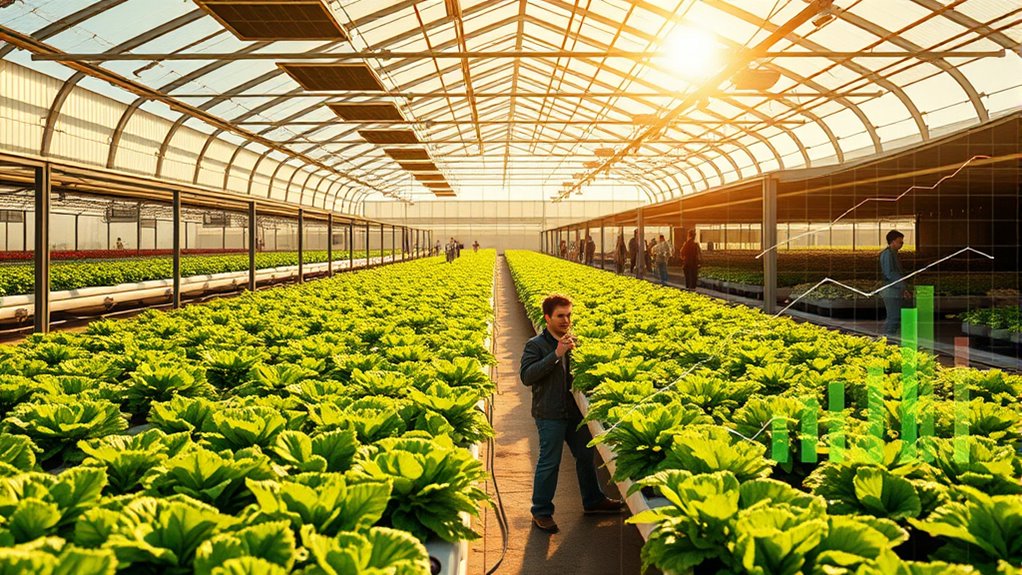
The U.S. greenhouse market, valued at USD 2.91 billion in 2023, is projected to grow at a CAGR of 8.8% through 2030. This growth is fueled by rising demand for sustainable, locally sourced produce and high-value crops like tomatoes and herbs. Additionally, resource-efficient practices in greenhouse farming can lead to significant reductions in water usage, further enhancing profitability. The increasing emphasis on sustainability and responsible investing in various sectors, including agriculture, further underscores the potential for growth in greenhouse farming. Furthermore, adopting proper planning can help optimize resource allocation and long-term profitability.
Technological advancements, such as automated climate control, enhance profitability and efficiency. Additionally, the incorporation of energy-efficient designs in greenhouse operations can contribute to reducing overall operational costs. Although initial operational costs may be high, the potential for premium pricing and consistent yields makes greenhouse farming a lucrative investment.
Plus, the increasing focus on organic produce creates niche markets, positioning you to capitalize on consumer preferences for eco-friendly options.
Embrace these trends to maximize your investment potential.
Environmental Impact and Resilience in Agriculture
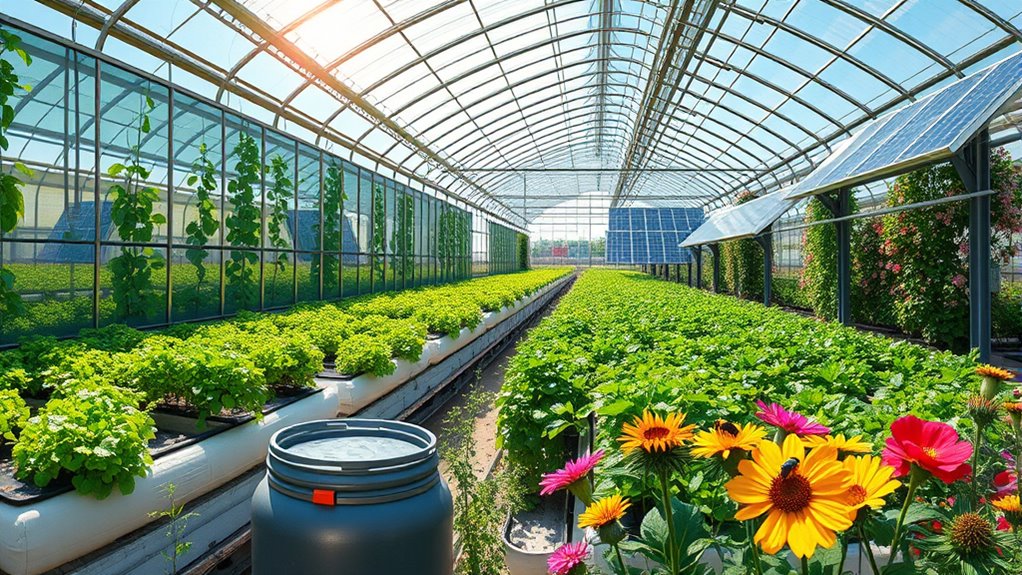
As greenhouse farming continues to gain traction, it's essential to understand its environmental impact and resilience in agriculture. The construction of greenhouses often involves materials like steel, which contributes considerably to carbon emissions. However, greenhouses excel in resource conservation, reducing water usage and minimizing transportation emissions by growing food locally. They also protect biodiversity by boosting yields and preserving natural spaces. Additionally, conventional food industry practices contribute to 37% of global greenhouse gas emissions, highlighting the importance of sustainable farming methods. With advanced climate control and irrigation systems, greenhouses adapt to changing weather conditions, ensuring consistent food production. Advance directives can help guide decision-making processes in agriculture, similar to how they assist in healthcare. By integrating renewable energy and reducing chemical use, they enhance sustainability. Furthermore, healthy ecosystems are vital for maintaining biodiversity and can be supported through innovative farming practices. Freshly squeezed juices, for example, can be a part of sustainable agricultural practices, as they promote the use of local produce which reduces transportation emissions. Despite some initial environmental costs, the overall benefits of greenhouse farming can lead to a more resilient and environmentally friendly agricultural future.
Future Innovations Shaping Greenhouse Operations
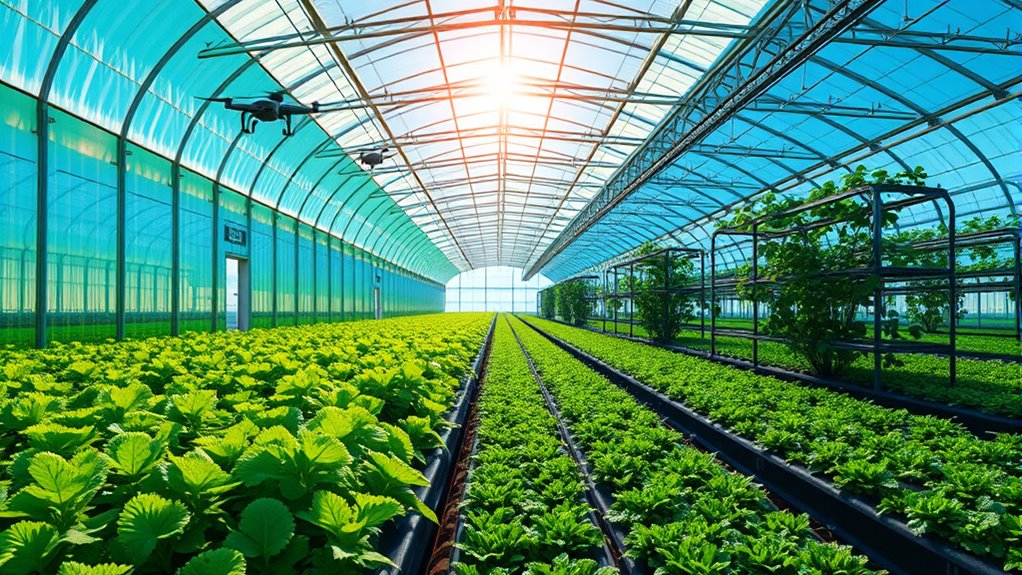
Emerging technologies are revolutionizing greenhouse operations, making them more efficient and sustainable.
Intelligent automation optimizes irrigation and climate control, reducing labor and enhancing productivity. You'll benefit from energy-efficient LED lighting that adjusts to different growth stages, cutting energy use considerably. Automated irrigation systems enhance disease prevention and pest management, ensuring healthier crops. Solar panels with battery storage can also provide a reliable power source for greenhouse operations, further contributing to sustainability. Additionally, integrating high-performance HVAC systems ensures that temperature regulation is optimized, promoting healthier plant growth while minimizing energy consumption. Regular maintenance of these systems can significantly improve their efficiency and longevity, resulting in even greater energy savings.
High-performance HVAC systems manage air quality and temperature, preventing diseases and minimizing energy consumption. Self-sufficient water systems, including rainwater harvesting, decrease water dependency. Data analytics provides real-time insights, helping you make informed decisions to boost yields. Additionally, innovative greenhouse designs and advanced materials guarantee durability and energy efficiency.
Addressing Challenges for Global Food Security
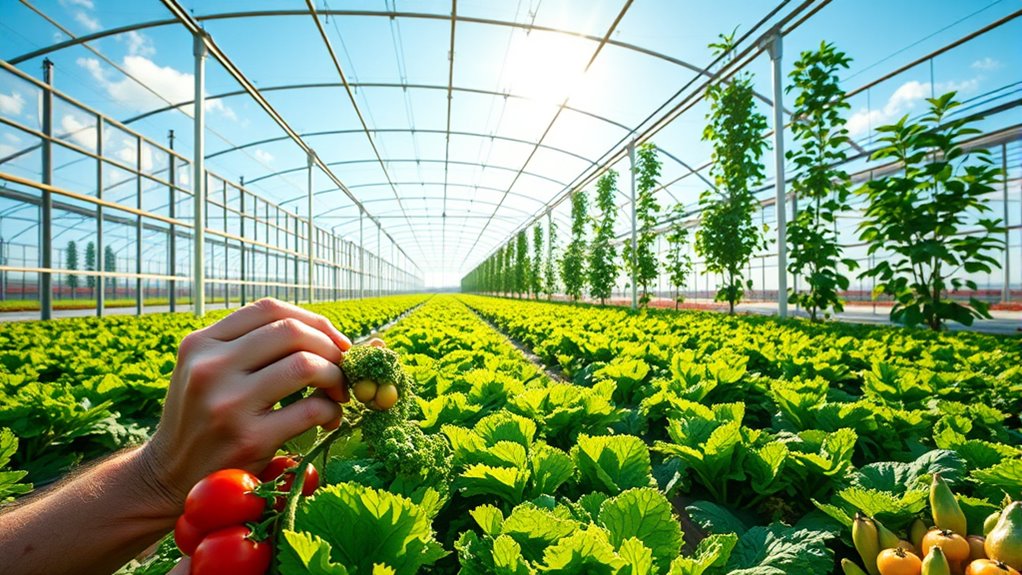
Addressing global food security challenges requires urgent action and innovative solutions. You can play a crucial role in mitigating issues like climate change, soil degradation, and water scarcity by supporting greenhouse farming. These controlled environments protect crops from extreme weather, allowing for year-round production and efficient water use. Additionally, greenhouse farming can achieve higher resource-use efficiency by reducing water usage to 10% of conventional methods. Effective ventilation in greenhouses helps maintain optimal growing conditions, enhancing plant health and productivity. Furthermore, incorporating omega-3 rich seeds like chia seeds into greenhouse farming can contribute to nutritional diversity and sustainability. Moreover, implementing water purification methods in greenhouse systems can further conserve resources and ensure crop health. As a consumer, you can advocate for sustainable practices that reduce food waste and promote local farms. Encourage governments to invest in agricultural research and prioritize food security initiatives. Collaborating with the private sector can also drive technological advancements in sustainable agriculture.
Frequently Asked Questions
What Crops Are Best Suited for Greenhouse Farming?
When considering what crops are best suited for greenhouse farming, think about high-demand options like tomatoes and leafy greens.
You can also grow fast-yielding microgreens and popular herbs year-round.
Don't overlook cucumbers and peppers, which thrive in controlled environments.
If you want specialized crops, consider cannabis or cut flowers for higher profit margins.
Always assess your greenhouse conditions to choose the right crops that match your climate and market needs.
How Do Greenhouses Affect Local Ecosystems?
Greenhouses substantially affect local ecosystems by enhancing biodiversity and improving air quality.
You'll notice how the controlled environments support various crops, which can filter air pollution and absorb carbon dioxide.
Additionally, they promote local food security by allowing year-round production, regardless of weather.
While construction might cause some pollution, the benefits of reducing transportation emissions and optimizing resource use often outweigh these impacts, contributing positively to the surrounding ecological conditions.
What Is the Initial Cost of Setting up a Greenhouse?
Setting up a greenhouse can cost you anywhere from $10,000 to over $100,000, based on factors like location and the technology you choose.
You'll need to take into account land acquisition costs, which can range from $500 to $2,000 monthly for leasing.
Building the structure itself may set you back between $5,000 and $30,000, depending on size and materials.
Don't forget additional expenses for climate control, irrigation, and equipment.
Planning ahead can help you budget effectively.
How Do Greenhouses Manage Pest Control Naturally?
Imagine walking through a vibrant greenhouse where ladybugs happily munch on aphids, keeping your plants healthy and thriving.
Greenhouses manage pest control naturally by introducing beneficial insects like ladybugs and parasitic wasps to target specific pests. You can also implement companion planting, using aromatic herbs to repel unwanted visitors.
What Skills Are Needed for Greenhouse Management?
To excel in greenhouse management, you'll need a blend of skills.
Excellent communication helps you coordinate your team effectively, while strong leadership guarantees efficient staff training.
You'll also benefit from knowledge in greenhouse operations, pest management, and plant care.
Financial management skills are essential for budgeting, and strategic planning prepares you for future growth.
Finally, staying updated on horticultural practices through continuous learning keeps you at the forefront of the industry.
Conclusion
As you step into the future of greenhouse farming, envision a vibrant ecosystem, where technology and sustainability intertwine like the roots of a mighty tree. Each innovation you embrace nurtures not just crops, but also the earth, symbolizing hope for food security and resilience. By cultivating these practices, you're not just planting seeds; you're sowing the promise of a greener tomorrow. Together, let's turn challenges into opportunities, ensuring that every harvest reflects our commitment to a thriving planet.

